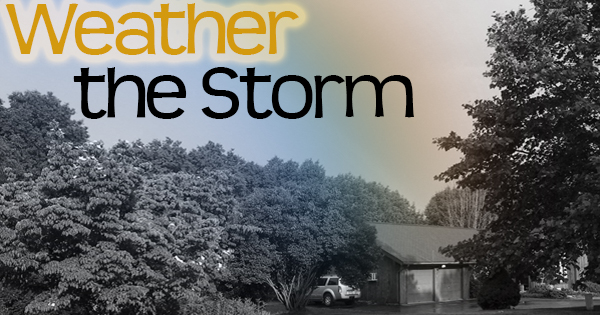
There are many things in life that are beyond our control. You know, things like, American Idol getting renewed for the 200th season, taxes, wives, the weather. Since I’m not Dr. Phil, I’d better stick to the weather. I might secretly wish I was Jim Cantore of The Weather Channel, but even though I’m not, weather plays a very important role in the technological world as well. Today marks post 134 of the Finish Line Blog. Time flies when you’re having fun! The 21st post was called, “Disasters Happen ‘Weather’ You’re Ready or Not”. Clever title I know. In that post, we covered surge protectors, uninterruptible power supplies (UPS), and the need for regular backups of your files in the event of a catastrophic storm. If you’d like to refresh your memory, click here. The goal for today is to walk you through a few important steps you can and should do whenever severe weather approaches.
The picture in the “Weather the Storm” graphic is of my house. It was taken in June 2007 as my mother and aunt returned home from an attempted night at the races. They drove to the track, the storm hit, and they came back in sunshine without seeing me turn a lap. It was a frustrating day, but made for a cool picture with a rainbow over the house. Because we’re all a little off upstairs, racers head to the racetrack no matter how bleak the weather outlook is. “If there’s a 90% chance of thunderstorms, there’s still a 10% chance it won’t rain.” Statements like these are the reasons I’m not actually Jim Cantore. On that day ten years ago, there was a chance of severe weather. Before we left on our hour long journey, we made sure that our computers were shut off in case a storm hit. You should too. Before leaving the house, or going to bed, shut your computer down when bad weather is looming. I don’t mean just shut the lid on your laptop, I want you to totally power it down. Should the power go out and your computer is on, at best you’ll lose anything you’re currently working on. At worst, you’ll fry components thanks to the sudden loss of power. As mentioned in the aforementioned “Disasters Happen ‘Weather’ You’re Ready or Not”, an uninterruptible power supply is a good idea because not only does it condition electricity to provide regulated voltage, it also allows you time to save the document you’re working on and shut your computer down safely when the power actually gets interrupted. Of course, if you’re not home, that doesn’t do you any good. But, if you are, you’ll be grateful that you planned ahead. Another note on UPS: many of them have a non-relenting, irritating beep when the power goes out. This alert tells you that the battery inside is running down. Simply hold the power button on the UPS to turn it off and save your eardrums in the process. Turn it on again by holding the power button down when power returns. It’s also a good idea to turn off any power strips your components are plugged into when strong storms are bearing down. Though your computer is shut down, there is still power flowing through it. Flip the switch on your surge protector and worry no more.
So, we’ve discussed what to do when severe weather is in our area. I guess the next logical thing to look at is how to know when it’s actually coming. Well, we can go all low-tech and look out the window, or grab our smartphone and do it the high-tech way. My weather app of choice is The Weather Channel’s app. The free app is available for both iPhone and Android devices. In my opinion there are three aspects of the app that make it a must download: the radar (don’t bother with the future radar – I said I wasn’t Dr. Phil, but I will quote him and say that “The best indicator of future behavior is past behavior.” The same holds true with radar), lightning strike tracker, and real-time rain. The lightning tracker tells you how far away and in what direction lightning was detected from your current location. Real-time rain sends a notification to tell you when rain will begin at your location. I always chuckle when it says that it will start raining at 5:57 rather than 6:00. More often than not though, they’re right, and it will rain at 5:57. Set these alerts up by opening the app and tapping the gear icon. Next, tap “My Alerts”, and turn on as many as you see fit. If you’re not a fan of The Weather Channel, AccuWeather is an excellent alternative. Instead of real-time rain, they actually offer a MinuteCast if you can believe it. Talk about confident! I actually find their forecasts to be more accurate than The Weather Channel’s, so AccuWeather isn’t just a clever name. Finally, if you want humor to go along with your weather forecast, check out WTForecast. It’s also a free app and available in iOS and Android. The forecast and current weather details are surprisingly accurate. The downside is that radar maps aren’t offered. The app does contain some profanity by default, so if you don’t wish to read any, tap the gear icon and turn it off.
Since we’re toiling away at our computers inside most of the time, we don’t often think that weather would be that much of a factor. The truth is, however, weather has a major impact. Keep yourself and your equipment safe by making sure you can “Weather the Storm”!
